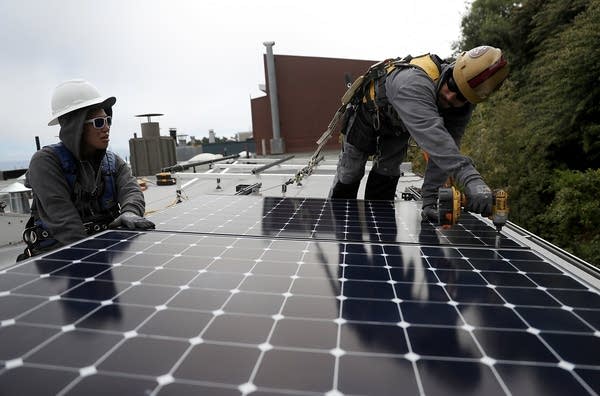California’s home solar mandate is now in effect. All newly constructed single-family homes (and most low-rise apartment buildings) are required to have solar panels on the roofs. In a state with lots of sunshine, that seems sensible, but it’s been a contentious path putting this law into place.
Builders say that at $8,000 to $10,000 per house, solar energy will drive up prices, and that could make the housing affordability crisis in the state even worse. Advocates say the expense will be offset by lower bills, and then there are the environmental benefits. But some are already looking for loopholes, including an option in the law to build so-called community solar projects, piping in energy from remote solar installations.
That part of the law isn’t exactly clear, meaning workarounds could weaken the mandate. I spoke with Pierre Delforge, a senior scientist with the Natural Resources Defense Council, about California’s new solar law. The following is an edited transcript of our conversation.
Pierre Delforge: This is the outcome of roughly 20 years of policy to develop the solar market to the point where now it is thriving without any financial incentives. It is cost effective enough that the California Energy Commission was able to make it standard as part of new construction. It’s really the outcome of successful market transformation policy around clean energy.
Jack Stewart: Why then is there still this controversy about who’s going to pay and how much it could add to the cost of buildings? Why are some builders trying to get out of doing this, basically?
Delforge: There are always people who don’t like to be told what to do. But market transformation cannot happen without policy. What we’re seeing here is a societal benefit that is critical and that requires this type of policy — it will not happen without it. We understand there are some philosophical concerns around policies that require solar or other energy-efficiency requirements. But this is really necessary to be able to get the societal benefit from bringing down the cost of solar and making it available to everyone.
Stewart: So you’re not concerned that some of these could be used as loopholes or workarounds? There’ve been a number of concerns about that raised recently.
Delforge: I’m aware of the concerns, and I think it’s important that we’ve defined the right way of doing this to make sure that this is really additional solar power that’s being built for the purpose of the new building. But it’s also one option that was agreed to as part of the building code development and adoption process. Community solar is one of the options for meeting these requirements. But, in most cases, we expect solar to be built on the building itself, but we also support the availability of other options to be able to meet this requirement.
Jack Stewart: Do you think this is one of those cases of what happens in California later happens in the rest of the country?
Delforge: Yeah, we think so. California is helping bring down the cost of solar power and other renewable energy technologies. And as the cost to entry in this market gets lower, it makes more and more sense for consumers everywhere in the country, and in the world, to be able to take advantage of this technology that saves them money. We do expect that the pioneering work in California will benefit other states and other countries.
Stewart: Do you think there’s an element of almost education needed? I recently bought a new home that was solar-ready apparently, but none of my neighbors have put solar panels on. It’s almost as if people aren’t aware of that option.
Delforge: Yes, definitely. I think people are not necessarily aware that they’re going to save significant amounts of money by having solar power. The more education and information that is available, and the more people see their neighbors do this, I think they will be more aware and there will be broader adoption. This new requirement by the building code, which is going to make sure that every new building has solar power, will definitely help raise public awareness and bring adoption of solar power, even in existing buildings.

Solar panels are old-school technology at this point — the principle dates back to the 1950s. In the half century they’ve been around, you would have thought there would have been any number of clever applications to utilize this emissions-free, cost-free source of energy that burns in the sky above us.
Host Molly Wood recently talked about exactly this with Danny Kennedy, the CEO of New Energy Nexus, which funds green projects. She asked him when tech companies are going to use their money to invent the widget that can solve climate change. You can hear more of that interview on “Make Me Smart With Kai & Molly.“
Don’t get me wrong, scientists are making great strides in bringing down the cost of solar, with new materials for panels and clear panels that could replace all the windows in buildings.
But environmental tech still doesn’t really get people’s pulses racing like a new phone or self-driving car does. That was evident at this year’s CES tech trade show, but I was happy to see an honoree innovation award go to Watergen, a company that has built a fridge-sized device that uses solar power to generate drinking water from humidity in the air. It’s a clever idea that could solve a bunch of problems in so many places where water and energy are scarce, but the sun shines bright.
But the fact that we’re still discussing whether solar should be on homes at all is really indicative of how slowly things move out here in the real world.